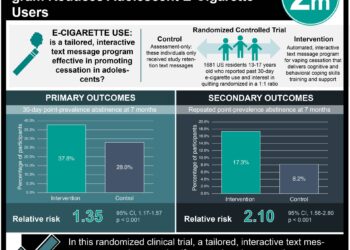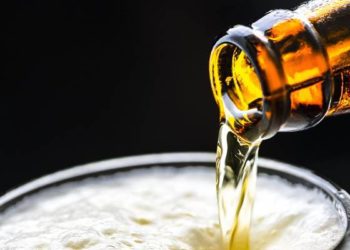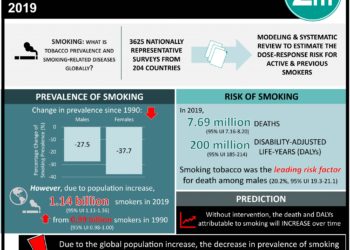Synthetic cannabinoid users more likely to use other illegal drugs
1. Among a representative sample of U.S. high school students, those who used synthetic cannabinoids (SC) were more likely to report more recent and more frequent use of other illegal drugs, compared to marijuana-only users.
2. SC users, compared to marijuana-only users, were more likely to report lower parental education and use of a larger number of illegal drugs. High frequency SC users were more likely to be male or African American and were more likely to use multiple illegal drugs compared to lower frequency users.
Evidence Rating Level: 2 (Good)
Study Rundown: Synthetic cannabinoids (SC) are a group of synthetically-made psychoactive substances with a wide range of side effect profiles and potencies of 2 to 100 times that of marijuana. Multiple studies have found strong associations between past SC use and past or current marijuana use. This study is the first to explore current use of SCs in a nationally representative sample. High school students across the country were surveyed about current SC, marijuana, and other drug use as part of larger cross-sectional study. Close to 3% of surveyed students reported SC use, with 8 out of 10 students reporting concurrent marijuana use and almost all reporting lifetime marijuana use. Students who used SC (in addition to marijuana) were more likely to report lower educational attainment in their parents, compared to marijuana-only users. Prevalence of use of other illegal drugs including LSD, opioids, cocaine, and heroin, were substantially higher among SC users compared to marijuana-only users. Among users of SC, those with the most frequent use were more likely to be boys or African American. They were also more likely to report the highest frequency use of marijuana. Finally, the proportion of users reporting using 2 to 4 additional drugs was positively associated with increased SC use. These results support early intervention from policymakers and clinicians to limit exposure and use of SCs. While this study is the first to examine current SC use, it is limited by the self-reported nature of the data.
Click to read the study, published today in Pediatrics
Relevant Reading: Synthetic cannabis: a comparison of patterns of use and effect profile with natural cannabis in a large global sample
Study Author, Dr. Joseph J. Palamar, PhD, MPH, talks to 2 Minute Medicine: New York University, Department of Population Health, Langone Medical Center, New York, New York
“Some students may deem real marijuana as a riskier substance than synthetic cannabinoids because it is illegal to possess. While arrest should in fact be a concern for marijuana users, these new synthetic compounds are becoming too dangerous and are in no way a safe alternative to marijuana. Better education is needed to stress the danger posed by synthetic cannabinoids.
Newer, more potent and more dangerous synthetic cannabinoid compounds continue to emerge, and users rarely know what they are actually using. In reality, effects of these compounds don’t feel very much like the effects of real marijuana at all, and use should be avoided as effects are not only often undesirable, but also commonly lead to poisonings.”
In-Depth [cross-sectional study]: This study included a nationally representative sample of high school students from the Monitoring the Future (MTF) survey. Students answering surveys in 2014 and 2015 were included (N = 7805). As part of the survey, high school students self-reported SC, marijuana, and other drug use, as well as current and past use. Overall, 2.9% of students reported SC current use. Of SC users, 80.6% reported concurrent marijuana use and 95.7% reported lifetime marijuana use. Compared to marijuana-only users, SC users were more likely to report parents having achieved low education (45% vs 32.2%, p= 0.02). Use of other drugs such as cocaine, opioids, and heroin, was higher among SC users compared to marijuana-only users (10.6% vs 3.3%, p<.001; 13.6% vs 5.7%, p <.01; 5.9% vs 0.1%, p<.0001, respectively). Those who used SC at least 10 days in the past 30 were more likely to be male (77.6% vs 22.1%, p< .01) and African American (43.4% vs 36% white, 20.6% Hispanic, p<.001). Compared to marijuana-only users, SC users were significantly more likely to use 2-4 illegal drugs other than marijuana (3.57, 95% CI 2.12-6.02). High frequency SC users were also more likely to report high frequency marijuana use, with 48.9% stating they used marijuana a minimum of 20 times in the past 30 days (p<.01).
Image: CC
©2015 2 Minute Medicine, Inc. All rights reserved. No works may be reproduced without expressed written consent from 2 Minute Medicine, Inc. Inquire about licensing here. No article should be construed as medical advice and is not intended as such by the authors or by 2 Minute Medicine, Inc.




![Active smoking cessation intervention may provide tangible results [Project CLIQ]](https://www.2minutemedicine.com/wp-content/uploads/2014/12/smoking-e1418644951268-350x250.jpg)


